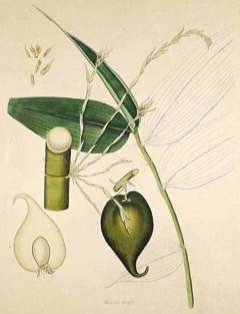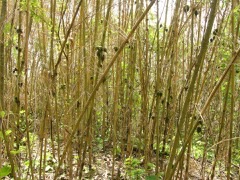 |
|
edibleplants.org |
 |
| flickr.com/photos/ricephotos/ |
Translate this page:
Summary
Physical Characteristics

 Melocanna baccifera is an evergreen Bamboo growing to 15 m (49ft) by 4 m (13ft) at a fast rate.
Melocanna baccifera is an evergreen Bamboo growing to 15 m (49ft) by 4 m (13ft) at a fast rate.
See above for USDA hardiness. It is hardy to UK zone 10. The flowers are pollinated by Wind.
Suitable for: medium (loamy) and heavy (clay) soils and prefers well-drained soil. Suitable pH: mildly acid, neutral and basic (mildly alkaline) soils. It can grow in semi-shade (light woodland) or no shade. It prefers moist soil.
UK Hardiness Map
US Hardiness Map
Synonyms
Bambusa baccifera Roxb. Melocanna bambusoides Trin.
Plant Habitats
Edible Uses
Edible Parts: Fruit Leaves Shoots
Edible Uses: Drink
Young shoots - cooked[310 ]. The shoots are also sliced and dried in the sun for preservation[310 ]. The remarkable large fruits are fleshy and edible[310 ]. They are used as a famine food[310 ]. The leaves may be used in brewing liquor[310 ].
References More on Edible Uses
Medicinal Uses
Plants For A Future can not take any responsibility for any adverse effects from the use of plants. Always seek advice from a professional before using a plant medicinally.
Tonic
Tabashir, which is a siliceous concretion found in the culms of the bamboo stem, can be collected from the culms[310 ]. It is used as a tonic in treating respiratory diseases.
References More on Medicinal Uses
The Bookshop: Edible Plant Books
Our Latest books on Perennial Plants For Food Forests and Permaculture Gardens in paperback or digital formats.

Edible Tropical Plants
Food Forest Plants for Hotter Conditions: 250+ Plants For Tropical Food Forests & Permaculture Gardens.
More

Edible Temperate Plants
Plants for Your Food Forest: 500 Plants for Temperate Food Forests & Permaculture Gardens.
More

More Books
PFAF have eight books available in paperback and digital formats. Browse the shop for more information.
Shop Now
Other Uses
Basketry Biomass Fibre Paper Weaving
The culms are widely used in house building; to make woven wares such as baskets, mats, handicrafts, wall plates, screens and hats; and for domestic utensils[310 ]. The culms are an important source of superior paper pulp[310 ].
Special Uses
Carbon Farming Food Forest
References More on Other Uses
Cultivation details
Industrial Crop: Biomass Management: Managed Multistem Regional Crop
A plant of the moist tropics. It grows best in areas where the mean annual temperature falls within the range 20 - 33°c, though it can tolerate 15 - 38°c[418 ]. It prefers a mean annual rainfall in the range 2,000 - 3,000mm, tolerating 600 - 4,400mm[418 ]. Succeeds in full sun or light shade[418 ]. Succeeds in moist soils, preferring a fertile medium to heavy soil[418 ]. Prefers a pH in the range 5.5 - 6.5, but tolerates 5 - 7[418 ]. Harvesting of the culms may start 5 - 6 years after planting[310 ]. Young shoots are harvested in the rainy season. Culms are considered mature when 2 years old[310 ]. The average green culm yield is estimated at 12,000 culms/ha per 3 years, weighing about 84 tonnes[310 ]. Other reported culm yield data per 3 years per ha in air dry weight are: 38 tonnes (Bangladesh), 21 tonnes (Myanmar) and 17.5 tonnes (India)[310 ]. Bamboos have an interesting method of growth. Each plant produces a number of new stems annually - these stems grow to their maximum height in their first year of growth, subsequent growth in the stem being limited to the production of new side branches and leaves. In the case of some mature tropical species the new stem could be as much as 30 metres tall, with daily increases in height of 30cm or more during their peak growth time. This makes them some of the fastest-growing species in the world[K ]. Seedlings, unlike those of most bamboos, grow vigorously from the beginning. By the end of their first year's growth they have usually produced 1 or 2 shoots, but up to 5 shoots can be produced[310 ]. The least shoot produced can be up to 3 metres tall[310 ]. The shoots are crowded together in a clump[310 ]. More shoots are produced during the second season - these can be up to 7 metres tall and the clump becomes larger[310 ]. By the fifth season, the culms have attained almost their maximum height, but they are still thin and crowded together[310 ]. Per clump, more than 70 culms may be present[310 ]. In later years, the culms become spaced out with the gradual extension of the rhizomes[310 ]. Clumps are mature after about 10 years, reaching 4 - 5 metres in diameter and producing 30 - 40 new culms annually[310 ]. Young shoots emerge above the soil during the rainy season and develop to their full height within 4 - 6 months[310 ]. Lateral branches emerge and develop in the following season[310 ]. Bamboos in general are usually monocarpic, living for many years before flowering, then flowering and seeding profusely for a period of 1 - 3 years before usually dying. The plant flowers gregariously, with a flowering cycle of 30 - 45 years. In the season before flowering no new shoots are produced. Flowering may continue for about 10 years over a tract that is sometimes called a flowering wave[310 ]. Soon after flowering, the leaves wither and fall, the culms turn yellow and the fruit forms rapidly, ripening and falling - often already germinating even before they fall[310 ]. Many fruits fail to mature and those produced from the earlier flowering part are larger than those from the later part[310 ]. Eventually, clumps that have flowered die[310 ]. The rhizomes are very vital and start growing easily - this means that eradication of the plant from cleared bamboo forest is very difficult because every rhizome part left in the ground quickly develops into a new plant[310 ].
Carbon Farming
-
Industrial Crop: Biomass
Three broad categories: bamboos, resprouting woody plants, and giant grasses. uses include: protein, materials (paper, building materials, fibers, biochar etc.), chemicals (biobased chemicals), energy - biofuels
-
Management: Managed Multistem
Regularly removing some multiple stems. A non-A non-destructive management systems maintaining the soil organic carbon.
-
Regional Crop
These crops have been domesticated and cultivated regionally but have not been adopted elsewhere and are typically not traded globally, Examples in this broad category include perennial cottons and many nuts and staple fruits.
References Carbon Farming Information and Carbon Sequestration Information
Temperature Converter
Type a value in the Celsius field to convert the value to Fahrenheit:
Fahrenheit:
The PFAF Bookshop
Plants For A Future have a number of books available in paperback and digital form. Book titles include Edible Plants, Edible Perennials, Edible Trees,Edible Shrubs, Woodland Gardening, and Temperate Food Forest Plants. Our new book is Food Forest Plants For Hotter Conditions (Tropical and Sub-Tropical).
Shop Now
Plant Propagation
Seed - when available, they afford the best means of propagation[310 ]. Sown in a nursery bed and only just cover the seeds. Germination usually takes place within a few days - up to 80% of the seed germinates if sown in a shady position, but only 33% in a sunny position[310 ]. Rhizome development begins 30 - 40 days after germination[310 ]. Due to its tall and soft stem, the seedling gets easily damaged during handling and transportation - therefore chopping the seedling stem tips at 3 - 5 nodes is generally recommended[310 ]. Frequent shifting of seedlings from one bed to another helps in minimizing root and rhizome intermingling at the nursery stage[310 ]. Normally, seed remains viable for about 35 days. Storage in air-conditioned rooms increases its lifespan up to 45 days, and when stored with dry sand in gunny bags, up to 60 days[310 ]. Single-culm clump division. These should be made from the youngest culms, while the lateral buds of the rhizome are still dormant, or before they have pushed more than 50 - 75mm[310 ]. Most of the culm and the long slender rhizome neck may be discarded for convenience[310 ]. Culm cuttings are preferably taken from 2-year-old culms[310 ].
Other Names
If available other names are mentioned here
Bambu mali, Bish, Kaninwa, Kauaung-wa, Kaucheu, Kayaung-wa, Kayin-wa, Khak-chat-dun, Mam-rua, Mautak, Metunga, Muli, Paiyya, Ta-bin-daing-wa, Tabinwa, Tarai, Wa mia, Wati, Wathwi, Watri,
Native Range
TROPICAL ASIA: Bangladesh, India (northeast), Nepal, Myanmar,
Weed Potential
Right plant wrong place. We are currently updating this section.
Please note that a plant may be invasive in one area but may not in your area so it's worth checking.
None Known
Conservation Status
IUCN Red List of Threatened Plants Status : This taxon has not yet been assessed

Growth: S = slow M = medium F = fast. Soil: L = light (sandy) M = medium H = heavy (clay). pH: A = acid N = neutral B = basic (alkaline). Shade: F = full shade S = semi-shade N = no shade. Moisture: D = dry M = Moist We = wet Wa = water.
Now available:
Food Forest Plants for Mediterranean Conditions
350+ Perennial Plants For Mediterranean and Drier Food Forests and Permaculture Gardens.
[Paperback and eBook]
This is the third in Plants For A Future's series of plant guides for food forests tailored to
specific climate zones. Following volumes on temperate and tropical ecosystems, this book focuses
on species suited to Mediterranean conditions—regions with hot, dry summers and cool, wet winters,
often facing the added challenge of climate change.
Read More
Expert comment
Author
(Roxb.) Kurz
Botanical References
Links / References
For a list of references used on this page please go here
A special thanks to Ken Fern for some of the information used on this page.
Readers comment
| Add a comment |
|
If you have important information about this plant that may help other users please add a comment or link below. Only comments or links that are felt to be directly relevant to a plant will be included. If you think a comment/link or information contained on this page is inaccurate or misleading we would welcome your feedback at [email protected]. If you have questions about a plant please use the Forum on this website as we do not have the resources to answer questions ourselves.
* Please note: the comments by website users are not necessarily those held by PFAF and may give misleading or inaccurate information.
To leave a comment please Register or login here All comments need to be approved so will not appear immediately.
|
Subject : Melocanna baccifera
|
|
|
|